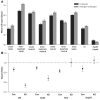Hormesis results in trade-offs with immunity
- PMID: 24862588
- PMCID: PMC4282086
- DOI: 10.1111/evo.12453
Hormesis results in trade-offs with immunity
Abstract
Many have argued that we may be able to extend life and improve human health through hormesis, the beneficial effects of low-level toxins and other stressors. But, studies of hormesis in model systems have not yet established whether stress-induced benefits are cost free, artifacts of inbreeding, or come with deleterious side effects. Here, we provide evidence that hormesis results in trade-offs with immunity. We find that a single topical dose of dead spores of the entomopathogenic fungus, Metarhizium robertsii, increases the longevity of the fruit fly, Drosophila melanogaster, without significant decreases in fecundity. We find that hormetic benefits of pathogen challenge are greater in lines that lack key components of antifungal immunity (Dif and Turandot M). And, in outbred fly lines, we find that topical pathogen challenge enhances both survival and fecundity, but reduces ability to fight off live infections. The results provide evidence that hormesis is manifested by stress-induced trade-offs with immunity, not cost-free benefits or artifacts of inbreeding. Our findings illuminate mechanisms underlying pathogen-induced life-history trade-offs, and indicate that reduced immune function may be an ironic side effect of the "elixirs of life."
Keywords: Drosophila melanogaster; ecological immunity; fitness; hormesis; life-history evolution; trade-offs.
© 2014 The Author(s).
Figures



References
-
- Brun S, Vidal S, Spellman P, Takahashi K, Tricoire H. Lemaitre B. The MAPKKK Mekk1 regulates the expression of Turandot stress genes in response to septic injury in Drosophila. Genes Cells. 2006;11:397–407. - PubMed
-
- Brzek P. Konarzewski M. Relationship between avian growth rate and immune response depends on food availability. J. Exp. Biol. 2007;210:2361–2367. - PubMed
-
- Calabrese EJ. Hormetic dose-response relationships in immunology: occurrence, quantitative features of the dose response, mechanistic foundations, and clinical implications. Crit. Rev. Toxicol. 2005;35:89–295. - PubMed
-
- Calabrese V, Cornelius C, Dinkova-Kostova AT, Iavicoli I, Di Paola R, Koverech A, Cuzzocrea S, Rizzarelli E. Calabrese EJ. Cellular stress responses, hormetic phytochemicals and vitagenes in aging and longevity. Biochim. Biophys. Acta. 2012;1822:753–783. - PubMed
Publication types
MeSH terms
Grants and funding
LinkOut - more resources
Full Text Sources
Other Literature Sources
Molecular Biology Databases
